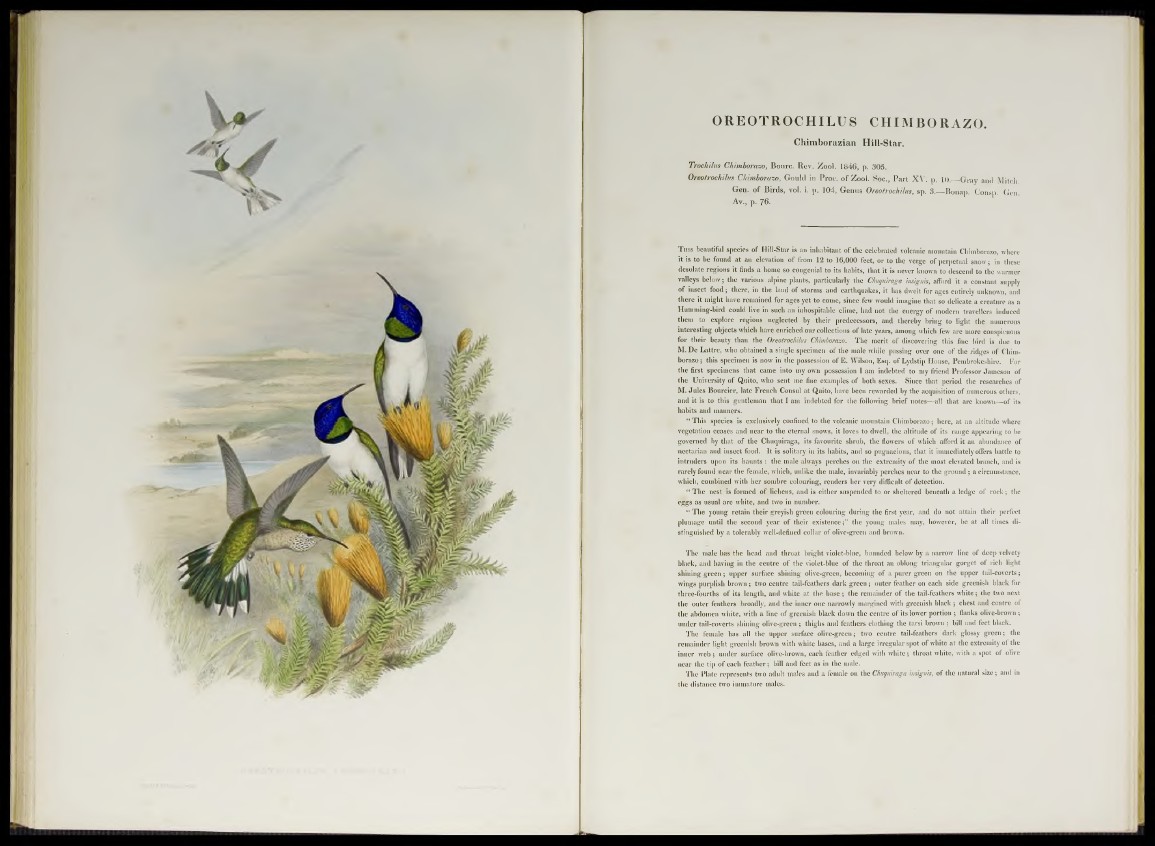
OREOTROCHILUS CHIMBORAZO.
Chimborazian Hill-Star.
Trochilus Chimborazo, Bourc. Rev. Zool. 1846, p. 305.
Oreotrochilus Chimborazo, Goulcl in Proc. of Zool. Soc., P a rt XV. p. 10.— Gray and Mitch.
Gen. of Birds, vol. i. p. 104, Genus Oreotrochilus, sp. 3.—Bonap. Consp. Gen.
Av., p. 76.
T h is beautiful species of Hill-Star is an inhabitant of the celebrated volcanic mountain Chimborazo, where
it is to be found at an elevation of from 12 to 16,000 feet, or to the verge of perpetual snow; in these
desolate regions it finds a home so congenial to its habits, that it is never known to descend to the warmer
valleys below; the various alpine plants, particularly the Cliuquiraga imignis, afford it a constant supply
of insect food; there, in the land of storms and earthquakes, it has dwelt for ages entirely unknown, and
there it might have remained for ages yet to come, since few would imagine that so delicate a creature as a
Humming-bird could live in sucli an inhospitable clime, had not the energy of modern travellers induced
them to explore regions neglected by their predecessors, and thereby bring to light the numerous
interesting objects which have enriched our collections of late years, among wliich few are more conspicuous
for their beauty tlian the Oreotrochilus Chimborazo. The merit of discovering this fine bird is due to
M. De Lattre, who obtained a single specimen of the male while passing over one of the ridges of Chimborazo
; this specimen is now in the possession of E. Wilson, Esq. of Lydstip House, Pembrokeshire. For
the first specimens that came into my own possession I am indebted to my friend Professor Jameson of
the University of Quito, who sent me fine examples of both sexes. Since that period the researches of
M. Jules Bourcier, late French Consul at Quito, have been rewarded by the acquisition of numerous others,
and it is to this gentleman that I am indebted for the following brief notes—all that are known—of its
habits and manners.
“ This species is exclusively confined to the volcanic mountain Chimborazo; here, at an altitude where
vegetation ceases and near to the eternal snows, it loves to dweil, the altitude of its range appearing to be
governed by that of the Cliuquiraga, its favourite shrub, the flowers of which afford it an abundance of
nectarian and insect food. It is solitary in its habits, and so pugnacious, that it immediately offers battle to
intruders upon its haunts : the male always perches on the extremity of the most elevated branch, and is
rarely found near the female, which, unlike the male, invariably perches near to the ground; a circumstance,
which, combined with her sombre colouring, renders her very difficult of detection.
“ The nest is formed of lichens, and is either suspended to or sheltered beneath a ledge of rock; the
eggs as usual are white, and two in number.
“ The young retain their greyish green colouring during the first year, and do not attain their perfect
plumage until the second year of their existence;” the young males may, however, be at all times di-
stinguished by a tolerably well-defined collar of olive-green and brown.
The male has the head and throat bright violet-blue, bounded below by a narrow line of deep velvety
black, and having in the centre of the violet-blue of the throat an oblong triangular gorget of rich light
shining green; upper surface shining olive-green, becoming of a purer green on the upper tail-coverts;
wings purplish brown ; two centre tail-feathers dark green; outer feather on each side greenish black for
three-fourths of its length, and white at the base; the remainder of the tail-feathers white; the two next
the outer feathers broadly, and the inner one narrowly margined with greenish black ; chest and centre of
the abdomen white, with a line of greenish black down the centre of its lower portion ; flanks olive-brown ;
under tail-coverts shining olive-green ; thighs and feathers clothing the tarsi brown ; bill and feet black.
The female has all the upper surface olive-green; two centre tail-feathers dark glossy green; the
remainder light greenish brown with white bases, and a large irregular spot of white at the extremity of the
inner web ; under surface olive-brown, each feather edged with white; throat white, with a spot of olive
near the tip of each feather; bill and feet as in the male.
The Plate represents two adult males and a female on the Chuquiraga imignis, of the natural size; and in
the distance two immature males.